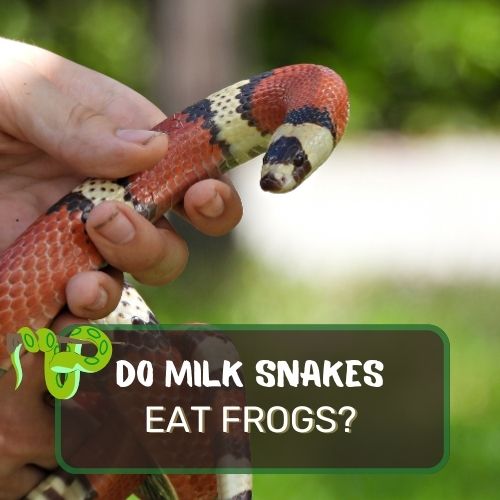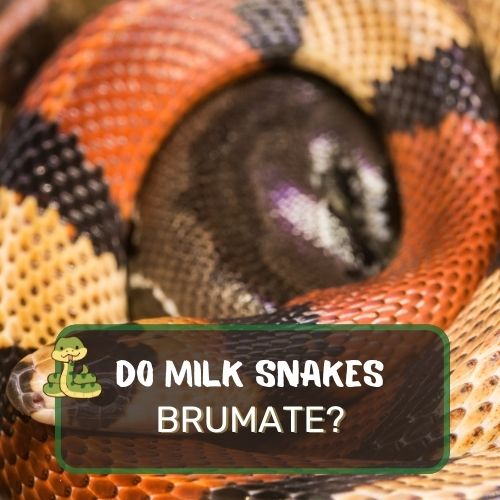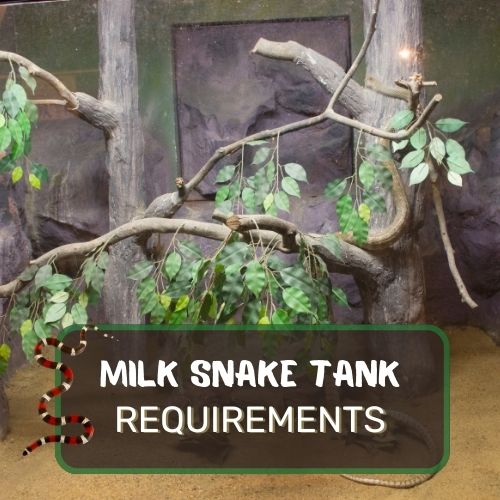Navigating the realm of reptiles, it’s easy to get tangled in the enigma of the milk snake and its peculiar tail-rattling antics. Is it mimicking the fearsome rattlesnake, or is there more to this behavior?
Yes, milk snakes can rattle their tails, especially when they feel threatened. However, unlike rattlesnakes, they lack a true rattle. Instead, the sound is produced when they shake their tails against dry leaves or other substrates.
This article dives deep into the world of milk snakes, deciphering their tail-tale signs and behaviors.
From understanding why these non-venomous snakes might mimic their venomous counterparts to discerning visual and behavioral clues that set them apart, we’ll journey through evolutionary perspectives, intriguing facts, and commonly asked questions.
Buckle up for a slithering adventure into the mysteries of the milk snake!

Table of Contents
Tail Rattling Behavior: The Real Deal
Have you ever stumbled upon a vibrant, slithering creature in the wild and heard a peculiar rattling sound? Your heart might’ve skipped a beat, wondering if you’ve encountered the notorious rattlesnake.
But wait, could it be a milk snake? Let’s dive into this intriguing world of reptilian behavior to find out!
Instances where milk snakes rattle their tails
Milk snakes, known for their vivid, tricolor patterns, have a quirky little behavior. In certain situations, they’ve been observed to shake or rattle their tails. This usually happens when they feel threatened or cornered.
Picture this: you’re hiking and you accidentally come a bit too close to a milk snake. Feeling vulnerable, the snake might start to wiggle its tail against the dry leaves or gravel. This creates a buzzing or rattling sound eerily reminiscent of the famous rattlesnake’s warning.
Reasons behind this behavior
Now, why would a harmless milk snake want to mimic such a dangerous sound? Well, it’s all about survival. In the wild, deception can be a lifesaver.
If a potential predator thinks the milk snake is a venomous rattlesnake, it might decide to back off, giving our milk snake a chance to escape unharmed. Clever, right?
Mimicry is a common tactic in the animal kingdom. Think about the Viceroy butterfly resembling the bitter-tasting Monarch to avoid being eaten by birds.
The milk snake’s tail rattling behavior is a classic case of Batesian mimicry, where a harmless species adopts the warning signals of a harmful species.
The sound difference: Milk snake rattle vs. rattlesnake rattle
Though both sounds can be startling, there’s a distinct difference between the milk snake’s “rattle” and the rattlesnake’s signature sound.
The rattlesnake, as its name suggests, has specialized segments at the end of its tail that produce a distinct, crisp rattling when shaken. On the other hand, a milk snake doesn’t have these segments.
Instead, when it vigorously shakes its tail against a substrate, the sound produced is more of a rapid buzz.
To paint a clearer auditory picture, imagine the difference between a maraca being shaken and a buzzing bee. While they might sound somewhat similar, especially in a panic, a keen ear will pick up the difference.
In essence, the milk snake’s tail-rattling is a brilliant display of nature’s knack for deception and survival. It serves as a testament to how even the seemingly simple behaviors in the wild can have intricate evolutionary tales behind them.
So the next time you hear a mysterious rattle in the woods, take a moment to observe and listen. It might just be a milk snake telling its own fascinating story.

The Confusion: Rattlesnake vs. Milk Snake
For any outdoor enthusiast or reptile admirer, differentiating between a milk snake and a rattlesnake can sometimes be a tad tricky. It’s like mistaking a body double for a celebrity; they might look eerily similar, but there are subtle differences.
Let’s dive into this world of reptilian doppelgängers, shall we?
The iconic rattle of the rattlesnake
First and foremost, the rattlesnake’s rattle is iconic. No Hollywood star has anything on this signature sound. This rattle is made up of a series of interlocked keratin segments.
When these segments vibrate against each other, they produce that quintessential rattling sound that’s a clear sign to back off. This rattle is both a warning and a defense mechanism, signaling potential threats to steer clear.
How milk snakes often get mistaken for rattlesnakes
So, why do milk snakes get roped into this identity crisis? Well, besides the tail-rattling behavior we already discussed, their color patterns add to the confusion.
Both these snakes flaunt beautiful bands across their bodies, which can easily be mistaken for one another, especially during a brief, panic-stricken encounter.
Key differences between the two species
But fear not! There are some key differences between the two. Firstly, milk snakes generally have a smoother and shinier appearance, while rattlesnakes have a more matte finish. Secondly, their band patterns, though similar, differ in layout and design.
And, of course, while a rattlesnake will proudly display its namesake rattle, milk snakes lack this physical feature.

Evolutionary Perspective: Why Mimic Rattlesnakes?
It’s truly fascinating how nature plays its cards. When it comes to survival, it seems like some animals got a tad craftier in the evolution department. And milk snakes, my friend, are among those cunning creatures.
The benefits of resembling a more dangerous snake
Think about it. If you were a small, non-venomous snake, wouldn’t you want to resemble a big, scary venomous one? It’s like wearing a superhero costume to a fight. Predators are less likely to mess with you if they believe there’s a risk involved.
Evolutionary advantages:
- Predator Deterrence: By mimicking the appearance and behavior of a venomous snake, milk snakes effectively deter potential threats. Few animals would willingly risk a venomous bite if they can help it.
- Increased Survival Rates: With fewer predators willing to take a bite, milk snakes sporting this deceptive appearance are likely to live longer and reproduce more, passing on these mimicry traits to future generations.
- Reduced Conflict: While the rattlesnake’s rattle is a warning, it’s also an invitation to conflict. Predators might still decide to engage, leading to potential harm for both parties. By just “faking” the rattle, milk snakes avoid these confrontations.
In the grand theater of nature, milk snakes have truly mastered the art of illusion, proving that sometimes, it’s not the strength but the strategy that counts. What a phenomenal game of survival they play!

How to Differentiate: Visual and Behavioral Clues
The world of snakes is a kaleidoscope of colors, patterns, and behaviors. For the untrained eye, telling one from another can be quite the challenge.
But, like a seasoned detective, with a keen eye and a bit of knowledge, you can quickly spot the differences between the deceptive milk snake and its more venomous counterpart, the rattlesnake.
So, grab your magnifying glass (not literally, please) and let’s delve into these intriguing clues!
The absence of a real rattle in milk snakes
Let’s begin with the most tell-tale sign: the rattle. While rattlesnakes possess a distinct rattle at the end of their tails, milk snakes are, well, rattle-less.
Instead of the interlocking segments that rattlesnakes boast, milk snakes have a smooth and continuous tail. The “rattle” sound they might produce comes not from a physical rattle but from their tail vibrating against the ground or foliage.
Color pattern variations: Red-touches-black vs. Red-touches-yellow
Here’s a little rhyme that might just save you from a lot of confusion (and potentially a snakebite): “Red touches yellow, kill a fellow. Red touches black, friend of Jack.” This rhyme refers to the band patterns on these snakes.
Rattlesnakes (or the venomous coral snake, which this rhyme is commonly associated with) typically have a pattern where the red bands touch yellow ones. In contrast, milk snakes have red bands touching black bands. Handy, right?
Size and body shape differences
Size does matter when differentiating between these two! Milk snakes tend to be slender and can range in size, but many common species are between 20-60 inches long.
Rattlesnakes, on the other hand, have a more robust, hefty appearance, especially the diamondback varieties, which can grow quite large.
Behavior when threatened
Now, while both snakes might rattle their tails when they feel threatened, there are some behavioral nuances. Rattlesnakes, being venomous, are more likely to stand their ground, coiling up and getting ready to strike if provoked.
Milk snakes, given their non-venomous nature, are more likely to look for an escape route, preferring flight over fight.

Wrapping Up
You’ve just journeyed through the captivating world of milk snakes and their tail-rattling behavior. While they might imitate the iconic rattle of their venomous counterparts, these snakes have a unique charm and strategy of their own.
From evolutionary advantages to distinguishing features, understanding these reptiles offers a richer appreciation of nature’s intricacies. Continue observing, learning, and being amazed by the wonders of the animal kingdom.
Your curiosity is a gateway to endless discoveries! Keep exploring.
FAQ
Navigating the world of snakes can leave many with questions aplenty. So, to quench your snake-related curiosity, here’s a quick FAQ session for you!
Which snake has a rattle on its tail?
The rattlesnake, as the name suggests, is the proud owner of that iconic rattle. It’s made up of interlocked keratin segments that create the distinctive sound when shaken.
How can you tell a milk snake?
Spotting a milk snake is like solving a colorful puzzle. Look for the slender body with bands where red touches black. And remember, no rattle on that tail!
Why is my snake wagging its tail?
Tail wagging or rattling in snakes, like the milk snake, can be a defensive behavior. It’s their way of saying, “Hey, I’m here, and I might be dangerous (even if I’m bluffing)!” It’s their quirky way of communicating potential danger or unease.




0 Comments